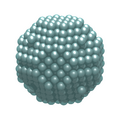This article includes a list of general references, but it lacks sufficient corresponding inline citations .(November 2013) |
This article needs additional citations for verification .(April 2023) |
It is proposed that this article be deleted because of the following concern:
If you can address this concern by improving, copyediting, sourcing, renaming, or merging the page, please edit this page and do so. You may remove this message if you improve the article or otherwise object to deletion for any reason. Although not required, you are encouraged to explain why you object to the deletion, either in your edit summary or on the talk page. If this template is removed, do not replace it . Contents
The article may be deleted if this message remains in place for seven days, i.e., after 21:53, 23 February 2025 (UTC). Find sources: "Waterman polyhedron" – news · newspapers · books · scholar · JSTOR Nominator: Please consider notifying the author/project: {{ subst:proposed deletion notify |Waterman polyhedron|concern=lack of notability}} ~~~~ |
In geometry, the Waterman polyhedra are a family of polyhedra discovered around 1990 by the mathematician Steve Waterman. A Waterman polyhedron is created by packing spheres according to the cubic close(st) packing (CCP), also known as the face-centered cubic (fcc) packing, then sweeping away the spheres that are farther from the center than a defined radius, [1] then creating the convex hull of the sphere centers.
- Cubic Close(st) Packed spheres with radius √24
- Corresponding Waterman polyhedron W24 Origin 1


Waterman polyhedra form a vast family of polyhedra. Some of them have a number of nice properties such as multiple symmetries, or interesting and regular shapes. Others are just a collection of faces formed from irregular convex polygons.
The most popular Waterman polyhedra are those with centers at the point (0,0,0) and built out of hundreds of polygons. Such polyhedra resemble spheres. In fact, the more faces a Waterman polyhedron has, the more it resembles its circumscribed sphere in volume and total area.
With each point of 3D space we can associate a family of Waterman polyhedra with different values of radii of the circumscribed spheres. Therefore, from a mathematical point of view we can consider Waterman polyhedra as 4D spaces W(x, y, z, r), where x, y, z are coordinates of a point in 3D, and r is a positive number greater than 1. [2]









